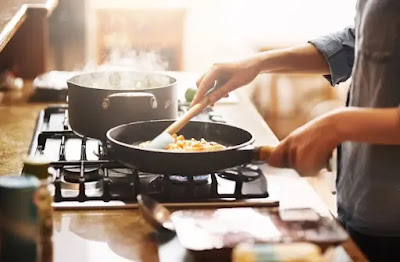Cooking with less oil doesn’t mean sacrificing flavor! By using the right techniques and ingredients, you can create delicious, healthy meals that are light on oil but rich in taste. From swapping in smart alternatives to enhancing your dishes with bold seasonings, this guide will show you how to master the art of low-oil cooking. Let’s dive in!
Why Cook with Less Oil?
Reducing oil in your cooking can offer numerous benefits:
- Healthier Meals: Lower oil content helps reduce calories and fat intake.
- Enhanced Natural Flavors: Allows the taste of fresh ingredients to shine.
- Cost-Effective: Stretch your oil supply further and save money.
- Eco-Friendly: Less oil use means less waste and fewer resources consumed.
Steps to Cook with Less Oil
1. Use Non-Stick Cookware
Investing in high-quality non-stick pans minimizes the need for oil.
- Perfect for Sautéing: Use non-stick surfaces to cook vegetables or proteins with minimal or no oil.
- Durability Matters: Choose pans with a durable coating to prevent sticking over time.
2. Opt for Oil Alternatives
Swap traditional oils for other flavorful and healthy options.
- Broth or Stock: Use vegetable or chicken broth to sauté vegetables or deglaze pans.
- Cooking Sprays: Lightly mist pans with cooking spray to reduce oil usage.
- Yogurt or Applesauce: Substitute in baking for moist, oil-free results.
3. Master Flavorful Techniques
Boost flavor through methods other than frying.
- Roasting: Use parchment paper to roast veggies without sticking.
- Grilling: Adds a smoky depth to meats and vegetables without requiring much oil.
- Steaming: Retains natural flavors and nutrients with no oil needed.
4. Embrace Bold Seasonings
Enhance the taste of your dishes with spices and herbs.
- Spices: Use smoked paprika, cumin, or turmeric for rich, complex flavors.
- Herbs: Fresh basil, cilantro, or rosemary can elevate your cooking.
- Acids: Lemon juice, vinegar, or tamarind can add brightness and depth.
5. Control Portions
When using oil, measure it to avoid over-pouring.
- Use a Measuring Spoon: Helps ensure precise amounts.
- Brush It On: Apply a thin layer of oil directly onto food instead of the pan.
Tips for Success in Low-Oil Cooking
- Preheat Your Pan: Heating the pan before adding food reduces sticking.
- Layer Flavors: Build taste by cooking aromatics like garlic and onions with minimal oil.
- Go Slow: Low and slow cooking helps food caramelize naturally.
- Experiment: Try new ingredients and methods to find what works best for you.
Common Mistakes to Avoid
- Skipping Preparation: Forgetting to preheat pans can cause sticking.
- Overloading the Pan: Crowding can prevent even cooking.
- Ignoring Seasoning: Under-seasoned dishes can lack depth when cooked with less oil.
Cooking with less oil is a simple and effective way to create healthier, flavorful meals. By using the right tools, techniques, and seasonings, you can transform your everyday cooking. Start small, experiment with these tips, and enjoy the journey to a healthier kitchen!
